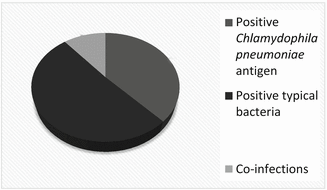No. of patients
Chl. pneumoniae
Typical pathogensa
Co-infection
Women
110
31 (28.2 %)
30 (27.3 %)
9 (8.2 %)
Men
64
14 (21.9 %)
22 (34.4 %)
3 (4.7 %)
Children
40
10 (25.0 %)
21 (52.5 %)
4 (10.0 %)
Total
214
55 (25.7 %)
73 (34.1 %)
16 (7.5 %)

Fig. 1
Distribution of typical and atypical pathogens underlying respiratory tract infections
4 Discussion
The most common etiological agents of bacterial community-acquired respiratory tract infections include Streptococcus pneumoniae, Streptococcus pyogenes, Haemophilus influenzae, Moraxella catarrhalis, and atypical bacteria such as Chlamydophila pneumoniae, Mycoplasma pneumonia, and Legionella pneumophila. Infections caused by atypical pathogens are not characterized by specific clinical course; therefore they are difficult to diagnose empirically. In addition, recommendations do not point to a single standardized diagnostic test which could distinguish between typical and atypical pathogens. A high percentage of specific antibodies to Chl. pneumoniae in the general population indicate the appreciable prevalence of infections with this microorganism. In a study of Miyashita et al. (2001), the occurrence of antibodies against Chl. pneumoniae, indicative of previous infection, was 58.8 % in men and 39.6 % in women, although the acute signs of infection were manifest in just 10.6 % of these cases. Acute phase of infection often leads to cough and hoarseness lasting many weeks, whereas chronic phase of infection is generally asymptomatic.
Epidemiological data on the incidence of infection caused by Chl. pneumoniae are variable, depending on the diagnostic methods used. Direct methods, such as PCR or cell culture, demonstrate that Chl. pneumoniae infection also affects young children (She et al. 2010; Michelow et al. 2004). Modern molecular techniques allow detecting the presence of pathogens in infants, where the widely used serologic tests usually fail to confirm the occurrence of infection caused by this pathogens (Verkooyen et al. 1998). Interestingly, publications of many authors point to large differences regarding the prevalence of Chl. pneumoniae in respiratory tract infections in children; ranging from about 10 % in hospitalized patients and 21–43 % in outpatients. However, the prevalence of Chl. pneumoniae may be underestimated due to a relatively low rate of acute infection requiring outright medical intervention (Choroszy-Krol et al. 2010, 2014; Schmidt et al. 2003; Normann et al. 1998). Concerning the etiological factors of respiratory tract infections, it is important to consider co-infections, which are quite common. In the course of Chl. Pneumoniae-induced acute pharyngitis in children, this pathogen was found in 3 % of patients, while other co-infecting bacterial pathogens were isolated in 13 % of cases (Esposito et al. 2004). Schmidt et al. (2003) have demonstrated a much higher proportion of infections caused by Chl. pneumoniae, amounting to 28 %, in which the antigen was found in 25 %. The present results are generally in line with those findings, although we found a lower co-infection rate with other bacterial pathogens, which may be related to a different patient population studied or different diagnostic methods.
Stay updated, free articles. Join our Telegram channel

Full access? Get Clinical Tree


